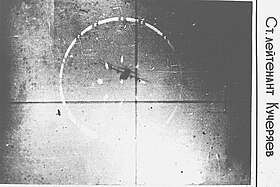
The Lockheed AC-130 gunship is a heavily armed, long-endurance, ground-attack variant of the C-130 Hercules transport, fixed-wing aircraft. It carries a wide array of ground-attack weapons that are integrated with sophisticated sensors, navigation, and fire-control systems. Unlike other modern military fixed-wing aircraft, the AC-130 relies on visual targeting. Since its large profile and low operating altitudes around 7,000 feet make it an easy target, its close air support missions are usually flown at night.
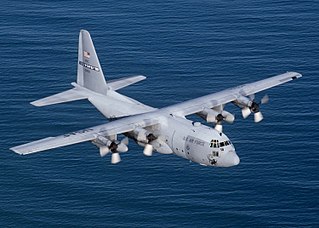
The Lockheed C-130 Hercules is an American four-engine turboprop military transport aircraft designed and built by Lockheed. Capable of using unprepared runways for takeoffs and landings, the C-130 was originally designed as a troop, medevac, and cargo transport aircraft. The versatile airframe has found uses in other roles, including as a gunship (AC-130), for airborne assault, search and rescue, scientific research support, weather reconnaissance, aerial refueling, maritime patrol, and aerial firefighting. It is now the main tactical airlifter for many military forces worldwide. More than 40 variants of the Hercules, including civilian versions marketed as the Lockheed L-100, operate in more than 60 nations.

The Lockheed U-2, nicknamed "Dragon Lady", is an American single-engine, high altitude reconnaissance aircraft operated from the 1950s by the United States Air Force (USAF) and the Central Intelligence Agency (CIA). It provides day and night, high-altitude, all-weather intelligence gathering.

The Lockheed HC-130 is an extended-range, search and rescue (SAR)/combat search and rescue (CSAR) version of the C-130 Hercules military transport aircraft, with two different versions operated by two separate services in the U.S. armed forces.
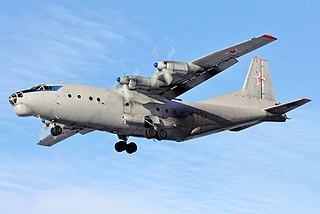
The Antonov An-12 is a four-engined turboprop transport aircraft designed in the Soviet Union. It is the military version of the Antonov An-10 and has many variants. For more than three decades the An-12 was the standard medium-range cargo and paratroop transport aircraft of the Soviet air forces. A total of 1,248 were eventually built.

The Lockheed EC-121 Warning Star was an American airborne early warning and control radar surveillance aircraft operational in the 1950s in both the United States Navy (USN) and United States Air Force (USAF).

The Lockheed DC-130 is a variant of the C-130 Hercules modified for drone control. It can carry four Ryan Firebee drones underneath its wings.
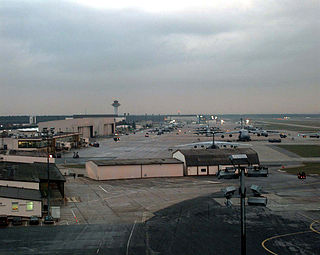
Rhein-Main Air Base was a United States Air Force air base near the city of Frankfurt am Main, Germany. It was a Military Airlift Command (MAC) and United States Air Forces in Europe (USAFE) installation, occupying the south side of Frankfurt Airport. Its military airport codes are discontinued. Established in 1945, Rhein-Main Air Base was the primary airlift and passenger hub for USAFE. It was billed as the "Gateway to Europe". It closed on 30 December 2005.

The 919th Special Operations Wing is an Air Reserve Component (ARC) unit of the United States Air Force. The 919 SOW is assigned to the Tenth Air Force of the Air Force Reserve Command (AFRC) and is stationed at Duke Field, Florida.

In 2002, two large airtankers – a Lockheed C-130 Hercules and a Consolidated PB4Y-2 Privateer – crashed about a month apart while performing aerial firefighting operations. These crashes prompted a review of the maintenance and use of the entire U.S. large airtanker fleet. Ultimately, the whole fleet was grounded, dramatically reducing the resources available to fight major wildfires. Both aircraft were owned by Hawkins & Powers Aviation of Greybull, Wyoming and operated under contract to the United States Forest Service (USFS). The crashes occurred in one of the worst fire seasons in the last half century, one in which 73,000 fires burned 7.2 million acres (29,000 km2) of land.

Nerkin Sasnashen is a village in the Talin Municipality of the Aragatsotn Province of Armenia. It is home to the ruins of a 7th-century Armenian monastery. The village contains a granite memorial marking the crash site of a United States Air Force C-130 shot down by Soviet MiG-17s on 2 September 1958 with the loss of 17 U.S. personnel.

The 1994 Iranian Air Force C-130 shootdown occurred on March 17, 1994, when an Iranian Air Force C-130E military transport aircraft, carrying Iranian embassy personnel from Moscow to Tehran, was shot down by Armenian military forces near the city of Stepanakert in Nagorno-Karabakh, an area which had been under armed conflict since 1988. The 32 people on board were killed in the crash.
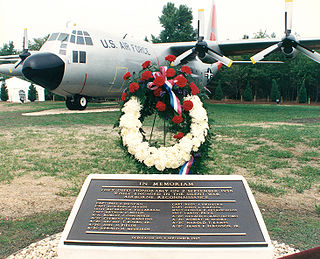
The United States National Vigilance Park (NVP) was a memorial to the military servicemen who participated in aerial reconnaissance during the Cold War. Dedicated on September 2, 1997, NVP was located just one block from the National Security Agency (NSA) headquarters at Fort George G. Meade, Maryland. It was previously open 24 hours a day for viewing. Military events connected with the Intelligence Community and/or personnel stationed at Ft. Meade or working at NSA were formerly scheduled through the National Cryptologic Museum (NCM), which is just one block west of the former park.

The 7499th Support Group is an inactive United States Air Force organization. Its last assignment was with the United States Air Forces in Europe, being stationed at Wiesbaden Army Airfield, West Germany. It was inactivated on 30 June 1974. Its mission was resumed by the 7575th Operations Group, which operated from Rhein-Main Air Base, West Germany from 1 July 1977 until its inactivation on 31 March 1991.

The 1981 Armenia mid-air collision occurred on 18 July 1981 when a Soviet Air Defense Forces Sukhoi Su-15 crashed into the tail of a Transporte Aéreo Rioplatense Canadair CL-44 commercial transport which had strayed into Soviet airspace over the Armenian Soviet Socialist Republic. The three crew and one passenger on the Argentine aircraft died; the Soviet pilot was able to eject to safety.
The Uragan-1 was the first generation of a Soviet automatic air defense interception system, and was a component of the Soviet Air Defence Forces protivovozdushnaya oborona strany. The concept began with a Soviet Council of Ministers resolution dated February 26, 1955 and the Ministry of Aviation Industry order dated March 8, 1955. The resolutions were in response to the threat from long-range supersonic bombers such as the United States' Convair B-58 "Hustler" and the equally threatening British Vickers Valiant, among others. The current generation is the Uragan-5B.

The Lockheed RC-130 Hercules are retired variants of the C-130 Hercules, designed for photographic or electronic reconnaissance missions.
